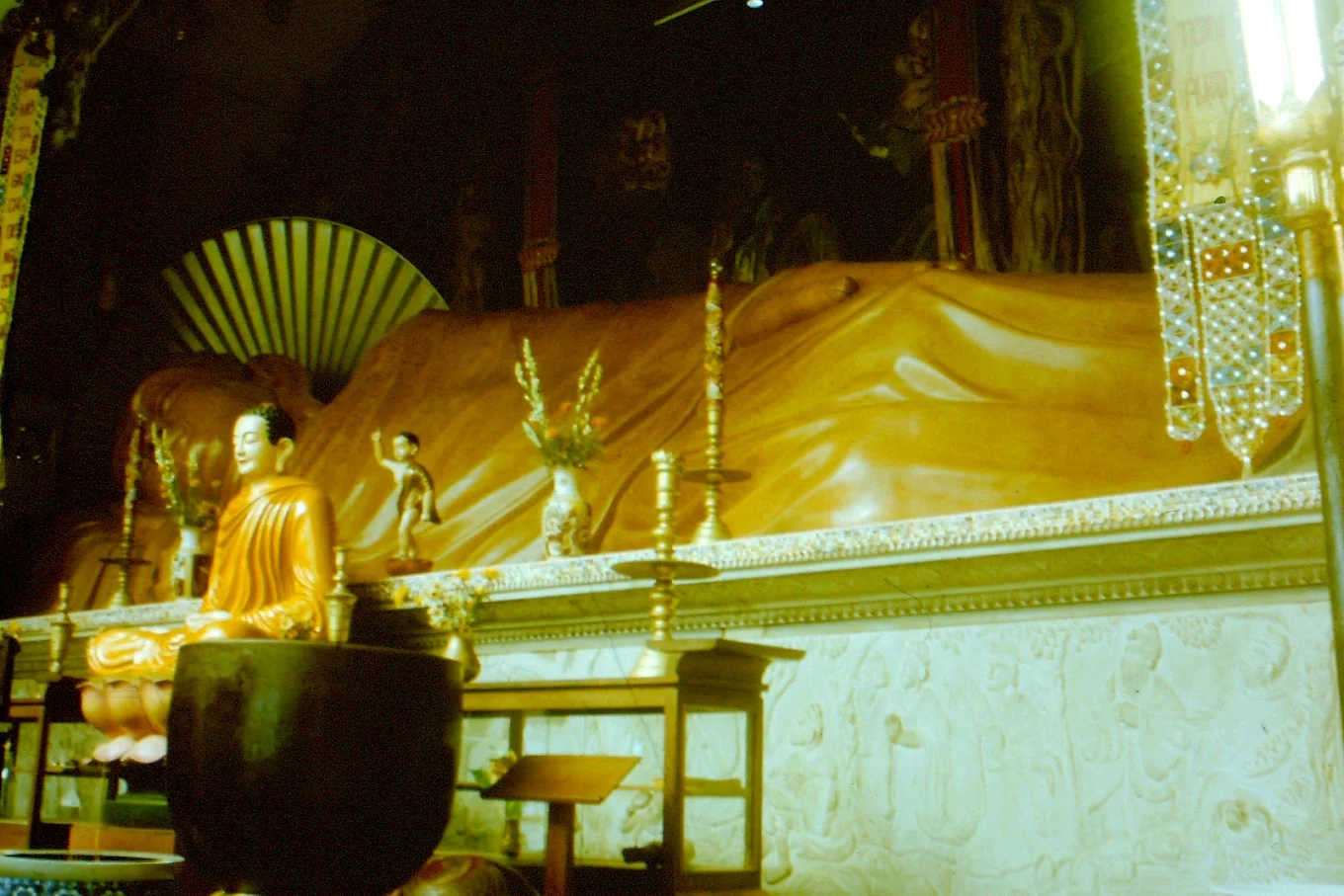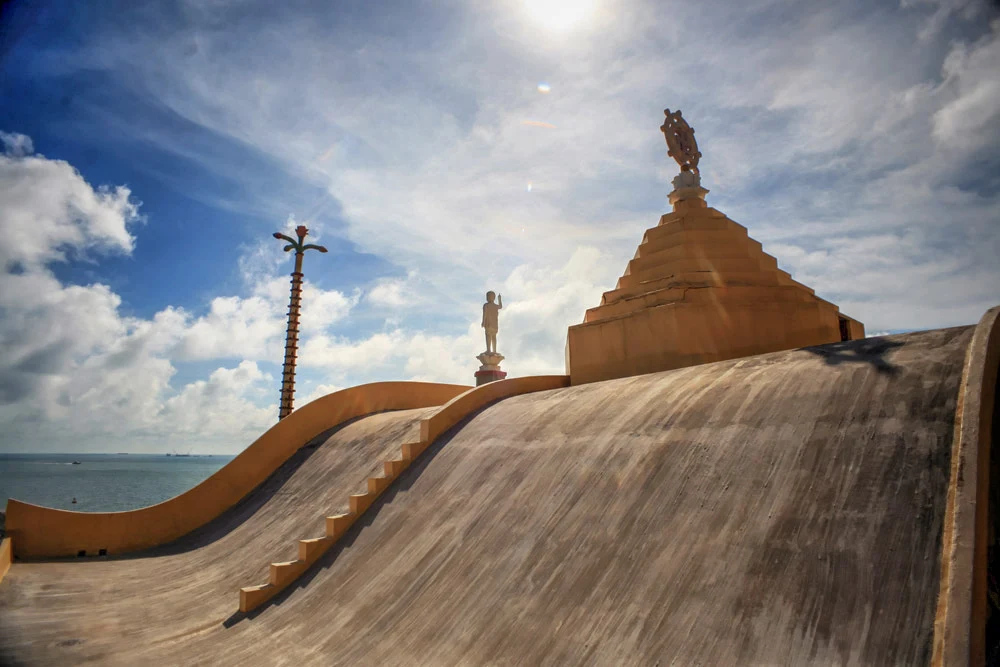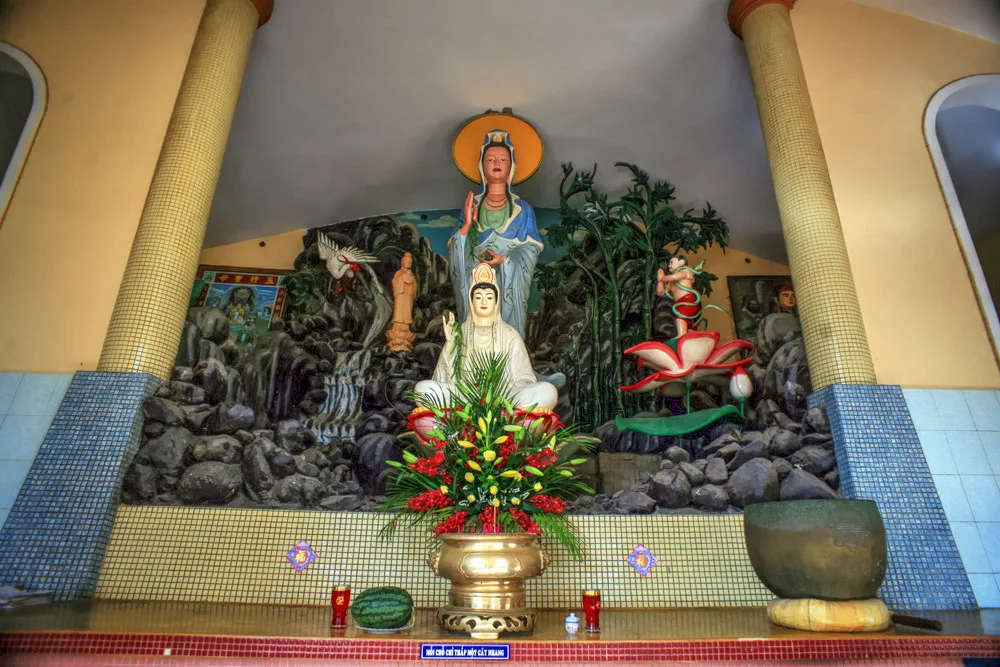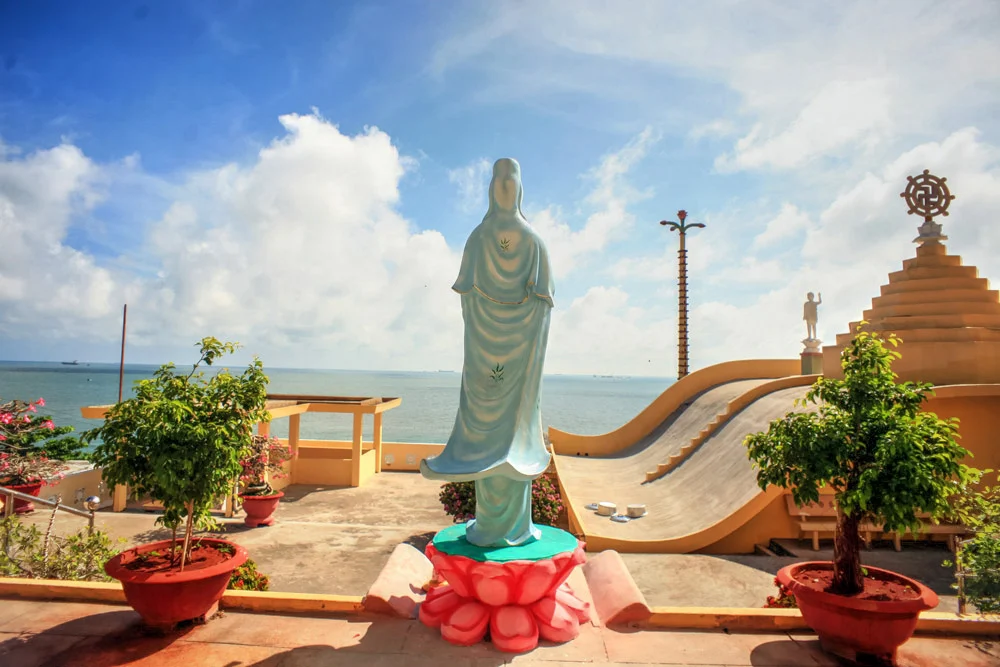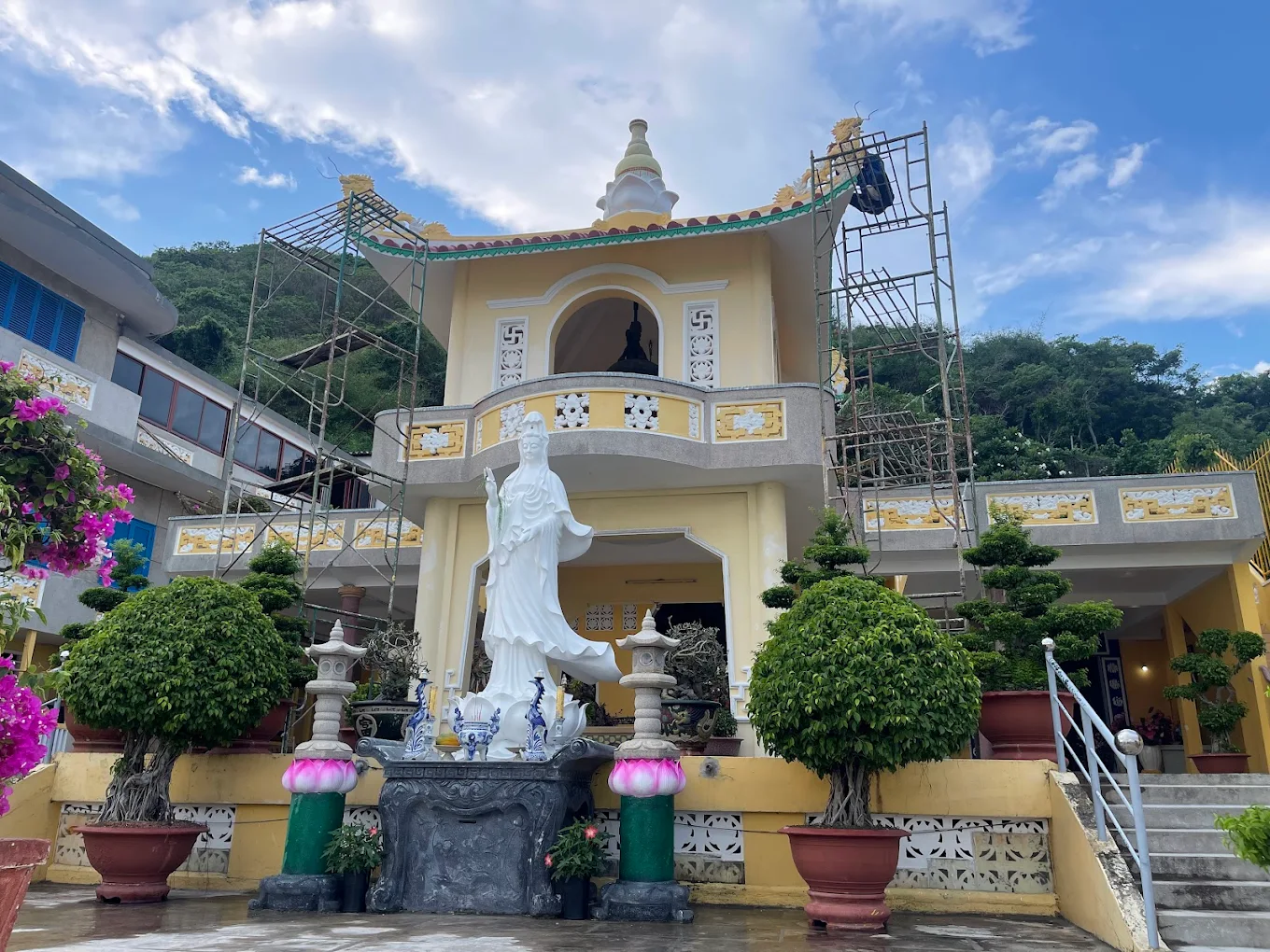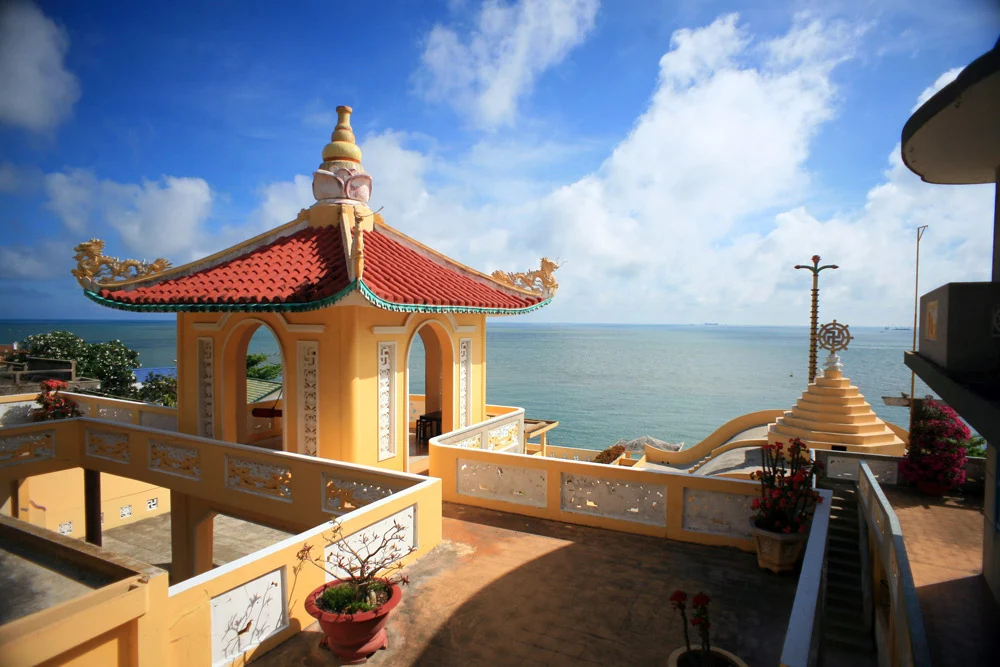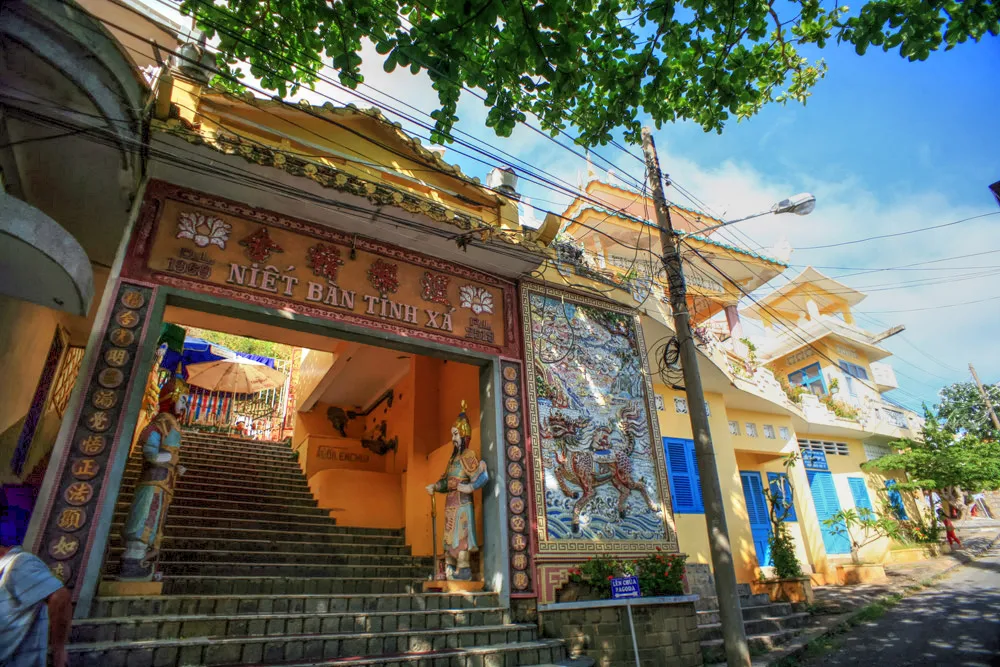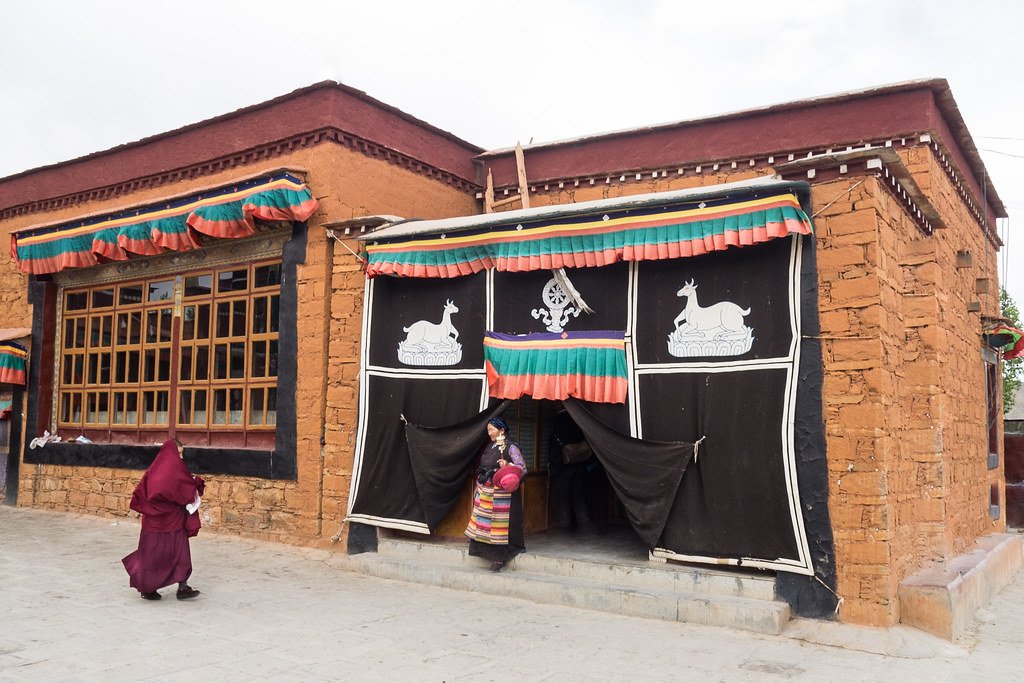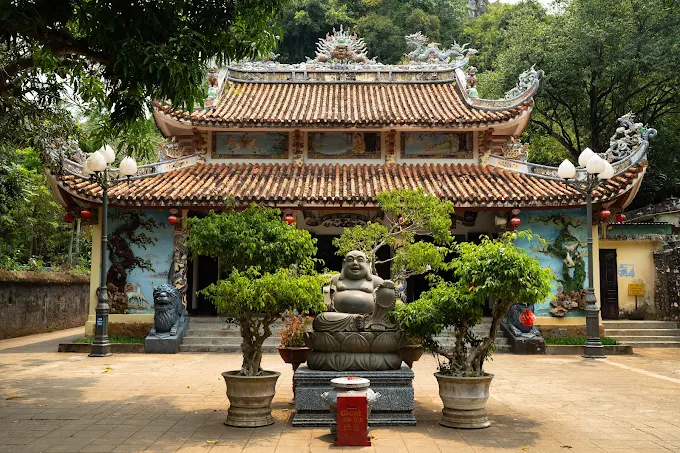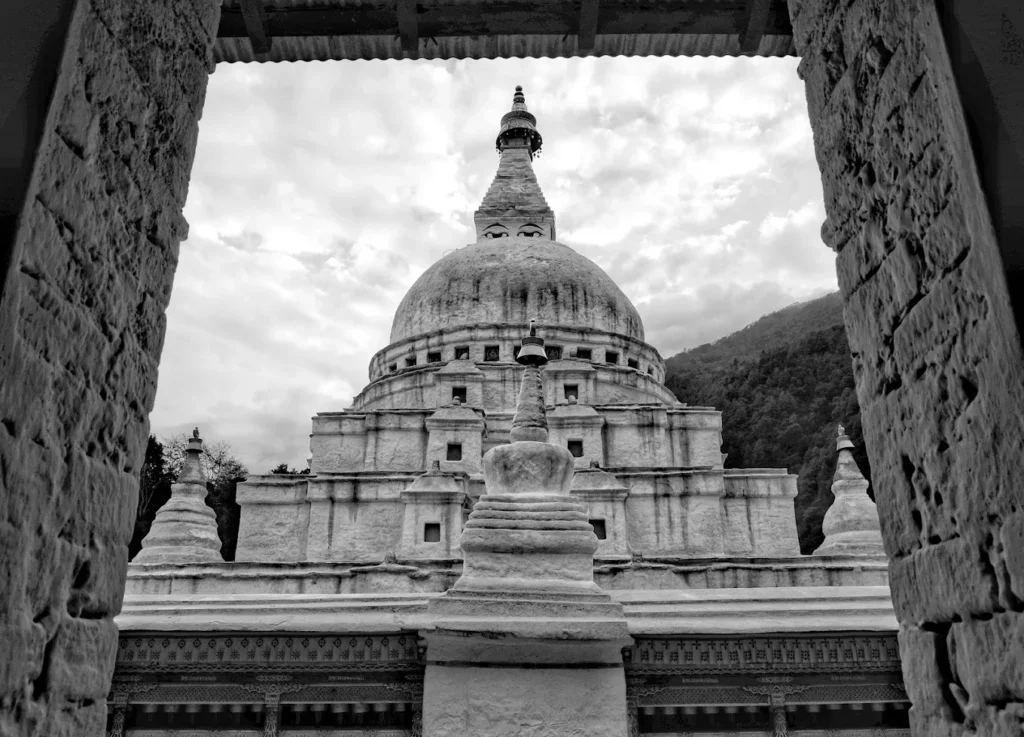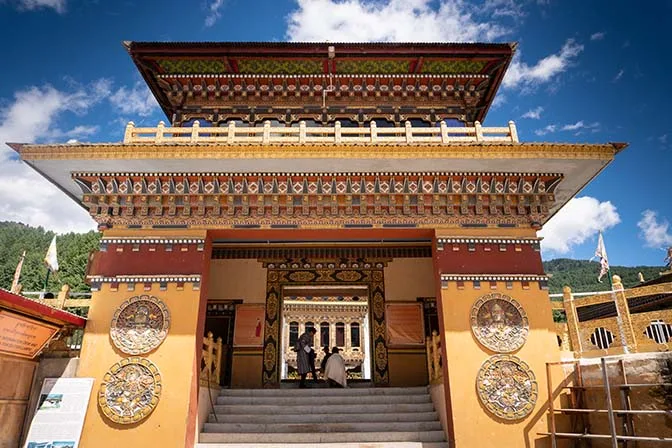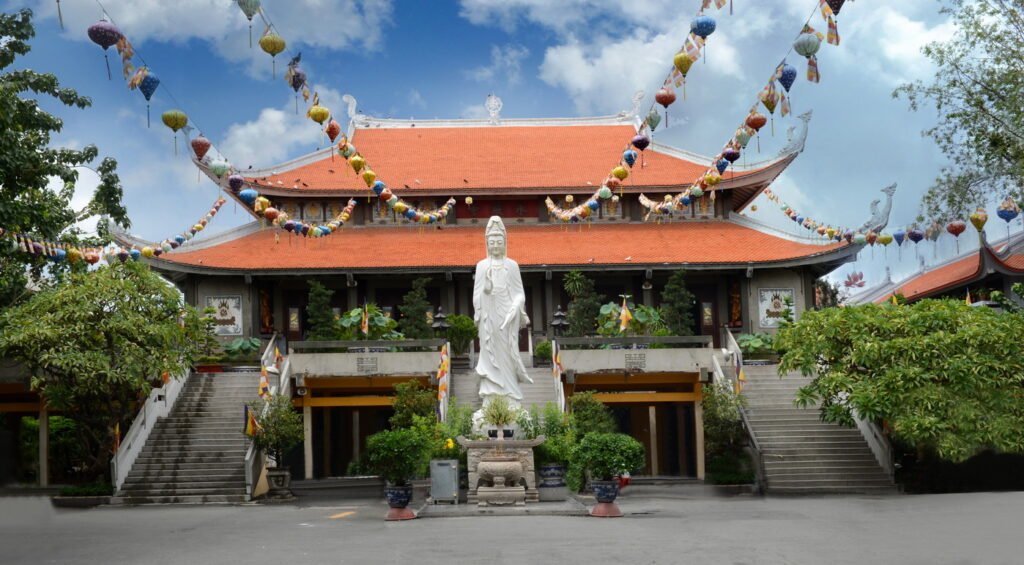Niet Ban Tinh Xa Pagoda: The Reclining Serenity of Vũng Tàu’s Coastal Nirvana
As twilight settles over Vũng Tàu’s Small Mountain, Niet Ban Tinh Xa Pagoda glows softly, its sea-facing main hall cradling the 12-meter Reclining Buddha statue, a vision of eternal peace. The air hums with Amitabha chanting, devotees seeking rebirth in Amitabha’s Western Paradise, their voices mingling with sandalwood incense and the gentle lapping of waves below. A lotus bloom drifts in the courtyard’s tranquil pond, reflecting the pagoda’s tiled roof, a masterpiece of Vietnamese artistry. This Mahayana sanctuary, poised between mountain and sea, invites all to find solace in its serene embrace and coastal vistas.
Overview and Significance
Introduction to Niet Ban Tinh Xa Pagoda
Niet Ban Tinh Xa Pagoda, perched on the slopes of Small Mountain (Núi Nhỏ) in Vũng Tàu, stands as one of the city’s most serene Mahayana Buddhist temples, its iconic 12-meter Reclining Buddha statue embodying the tranquility of the Pure Land tradition, which centers on devotion to Amitabha Buddha for rebirth in his Western Paradise. Located 2 kilometers from Vũng Tàu’s city center at 66/7 Hạ Long, this 1969-founded retreat blends East Asian elegance with Vietnamese architectural designs, offering breathtaking views of the East Sea. Its poetic main hall, rooftop terrace, and vibrant lunar festivals make it a cultural gem, drawing pilgrims, photographers, and spiritual seekers into a realm of coastal nirvana.
Historical Journey
Founded between 1969 and 1974 under the guidance of local Mahayana monks, Niet Ban Tinh Xa Pagoda emerged as a spiritual haven for Vũng Tàu’s coastal community, built with donations from devotees seeking a tranquil retreat. Designed with a “tọa sơn ngọa thủy” (mountain-backed, water-fronted) layout, the pagoda’s sea-facing orientation symbolizes harmony with nature. The 12-meter Reclining Buddha statue, completed in 1974, became its centerpiece, depicting Buddha’s entry into Nirvana. Renovations in the 1990s added a rooftop terrace and meditation spaces, enhancing accessibility.
Through Vũng Tàu’s rise as a coastal destination, the pagoda has remained a peaceful sanctuary, its history reflecting the city’s blend of spiritual devotion and natural beauty.
- Patronage: Supported by local Mahayana Buddhists and Vietnam Buddhist Sangha.
- Milestones: Founded 1969–1974; Reclining Buddha completed in 1974; renovated in 1990s.
Cultural Significance
Niet Ban Tinh Xa Pagoda is a vital hub for Vũng Tàu’s Mahayana community, fostering devotion to Shakyamuni Buddha and Avalokitesvara. Its Pure Land practices, centered on Amitabha chanting, offer solace to devotees and fishermen seeking protection from the sea. The pagoda hosts cultural events, like lunar festivals and peace-praying ceremonies, drawing crowds to its sea-facing grounds.
Regionally, it connects with Mahayana communities across Vietnam, sharing Pure Land teachings. Globally, it attracts tourists drawn to its photogenic Reclining Buddha and scholars studying Vietnam’s coastal Buddhist traditions, offering a glimpse into Mahayana’s compassion.
- Mahayana Hub: Preserves Pure Land practices in Vũng Tàu.
- Cultural Role: Hosts lunar festivals and peace-praying ceremonies.
- Global Appeal: Attracts tourists and scholars for its Reclining Buddha and coastal views.
Unique Legacy
The pagoda’s Reclining Buddha statue and sea-facing terrace define its legacy, embodying Mahayana’s serene nirvana. The 12-meter statue, poised on a lotus pedestal, and the terrace’s panoramic vistas symbolize eternal peace and harmony with the sea. Vietnamese tiled roofs and lotus motifs reflect local syncretism, while statues like Avalokitesvara anchor spiritual devotion.
This fusion of monumental sculpture, coastal serenity, and cultural artistry earns Niet Ban Tinh Xa Pagoda its title as the “Reclining Serenity of Vũng Tàu’s Coastal Nirvana,” a timeless beacon of faith.
- Reclining Buddha: 12-meter icon of nirvana.
- Rooftop Terrace: Sea-facing vantage point.
- Cultural Syncretism: Vietnamese Mahayana influences.
Community and Global Impact
Niet Ban Tinh Xa Pagoda thrives as a communal heart for Vũng Tàu’s Buddhist community. On lunar days, devotees gather before the Reclining Buddha to chant and offer incense, their prayers carried by sea breezes. Charity drives, supporting local fishermen, strengthen community bonds, while lunar festivals draw crowds with offerings to Avalokitesvara and candlelit processions.
Globally, the pagoda attracts spiritual tourists and photographers captivated by its coastal setting. The Vietnamese diaspora supports maintenance, reinforcing cultural ties. Its Reclining Buddha and sea-facing serenity cement its global role as a Mahayana sanctuary.
- Local Engagement: Hosts prayers, charity, and festivals.
- Global Reach: Draws tourists and photographers worldwide.
- Diaspora Support: Funded by Vietnamese communities abroad.
Architectural and Spiritual Features
Iconic Design
Niet Ban Tinh Xa Pagoda’s architecture blends Mahayana elegance with Vietnamese coastal charm, its 10,000-square-meter complex perched on Small Mountain, centered on the main hall, rooftop terrace, and serene courtyard. Its vibrant palette—gold, red, and white—celebrates Mahayana’s divine radiance, with Vietnamese tiled roofs and lotus motifs harmonizing with the sea’s rhythmic pulse.
The main hall’s sea-facing orientation and the terrace’s open design, rooted in Mahayana traditions, craft a sacred oasis of devotion and awe, offering unobstructed coastal vistas.
- Main Hall: Sea-facing structure with lotus motifs.
- Vietnamese Aesthetic: Tiled roofs and coastal design.
- Coastal Oasis: Harmonizes with Small Mountain’s sea views.
Key Structures
The main hall, housing the Reclining Buddha and other statues, is the pagoda’s spiritual heart, its ornate altars glowing under soft light. The rooftop terrace, accessible via a gentle staircase, offers panoramic views of Vũng Tàu’s coastline, ideal for meditation and photography. The courtyard, with lotus ponds and bodhi trees, serves as a communal space for festivals. Smaller shrines, featuring Thien (Good) and Ac (Evil) deity statues, dot the grounds, while a meditation pavilion provides quiet reflection.
These structures, blending spiritual and architectural beauty, create a serene Mahayana sanctuary.
- Main Hall: Spiritual heart with Reclining Buddha.
- Rooftop Terrace: Panoramic coastal vantage point.
- Courtyard: Communal space with lotus ponds.
Worshipped Statues
The main hall’s Reclining Buddha statue, a 12-meter gilded figure resting on a 2.5-meter lotus pedestal, depicts Buddha’s entry into Nirvana, its tranquil expression anchoring worship. Shakyamuni Buddha, a smaller gilded statue seated upright, symbolizes enlightenment. Avalokitesvara (Quan Thế Âm [觀世音]), crafted in white porcelain with a nectar vase, offers compassion. Smaller shrines house Maitreya, in gold leaf with a joyful smile, symbolizing future prosperity, and Ksitigarbha, in jade with a staff, guiding souls from suffering.
These statues, central to Mahayana worship, embody the pagoda’s spiritual essence, their iconography fostering devotion.
- Reclining Buddha: 12-meter gilded statue of nirvana.
- Shakyamuni Buddha: Gilded, symbolizing enlightenment.
- Avalokitesvara: Porcelain, offering compassion.
Materials and Techniques
The main hall, crafted with polished granite and ceramic tiles, showcases Vietnamese artisans’ mastery, its tiled roof with dragon motifs reflecting Mahayana symbolism. The Reclining Buddha, gilded and carved with lotus patterns, uses reinforced concrete for durability, a modern adaptation. Stone carvings of Buddhist tales adorn the courtyard, blending Vietnamese craftsmanship with Mahayana iconography. The rooftop terrace’s open design, with white balustrades, enhances coastal airflow, a hallmark of Vũng Tàu’s sea-inspired architecture.
These materials, grounded in Vietnamese syncretism, create a visually striking and spiritually resonant sanctuary.
- Granite Hall: Ceramic-tiled main hall with dragon motifs.
- Gilded Buddha: Concrete with lotus carvings.
- Stone Carvings: Vietnamese Buddhist tales.
Signature Elements
The Reclining Buddha statue and rooftop terrace are the pagoda’s signature elements, their serenity symbolizing Mahayana’s nirvana. The 12-meter statue, poised in eternal rest, and the terrace’s sweeping sea views anchor devotion. Vietnamese altars, with red and gold carvings, frame the statues, enhancing their spiritual presence.
These elements, blending monumental sculpture and coastal tranquility, define Niet Ban Tinh Xa Pagoda’s Mahayana identity, captivating all who visit.
- Reclining Buddha: 12-meter icon of nirvana.
- Rooftop Terrace: Sea-facing meditative space.
- Vietnamese Altars: Vibrant frames for statue worship.
Lesser-Known Features
The main hall’s ceiling, painted with lotus murals, forms a meditative canopy, often unnoticed in soft light. The courtyard’s stone lanterns, inspired by Vietnamese designs, cast gentle glows at dusk. Smaller shrines house ceramic sutra tablets, offering spiritual insight. A koi pond near the entrance, with lotus blooms, adds serene beauty, reflecting the pagoda’s tranquil depth.
These subtle details enrich Niet Ban Tinh Xa’s spiritual allure, rewarding attentive visitors.
- Lotus Murals: Meditative ceiling in the main hall.
- Stone Lanterns: Vietnamese-style courtyard glow.
- Koi Pond: Serene entrance feature.
Preservation and Evolution
The pagoda’s granite structures withstand Vũng Tàu’s coastal humidity, but the roof’s tiles require periodic cleaning by artisans. Volunteers maintain the courtyard, shrines, and statue altars. Renovations in the 1990s added the rooftop terrace and meditation pavilion, enhancing accessibility while preserving its 1974 heritage.
These efforts ensure Niet Ban Tinh Xa Pagoda remains a vibrant Mahayana temple, balancing tradition with modernity.
- Maintenance: Periodic tile cleaning.
- Modern Updates: Rooftop terrace and pavilion added in 1990s.
Rituals and Practices
Daily Sacred Rites
Each morning, Niet Ban Tinh Xa Pagoda resonates with Amitabha chanting, led by monks before the Reclining Buddha statue, invoking rebirth in the Western Paradise. Devotees offer incense at the incense house, their prayers rising before Avalokitesvara’s compassionate gaze. The meditation pavilion’s bell tolls, grounding worshippers in devotion.
Lay followers present lotus flowers and candles to Bodhisattva statues, bowing in reverence. The rooftop terrace invites serene sutra recitation, fostering Mahayana’s universal salvation.
- Morning Chanting: Amitabha chanting before statues.
- Incense Offerings: Prayers for rebirth in the Pure Land.
- Sutra Recitation: Quiet terrace devotion.
Unique Practices
The pagoda’s Pure Land devotion centers on Amitabha chanting, guiding devotees toward rebirth in the Western Paradise. Monks lead daily sessions before the Shakyamuni Buddha statue, cultivating mindfulness. Vegetarian offerings, placed in ornate bowls before Avalokitesvara, emphasize merit-making, reflecting Vietnamese Mahayana traditions.
On full-moon days, monks perform sea-blessing ceremonies from the rooftop terrace, unique to Niet Ban Tinh Xa’s coastal setting, offering prayers for Vũng Tàu’s fishermen, tied to the pagoda’s sea-facing harmony.
- Pure Land Chanting: Daily Amitabha sessions.
- Vegetarian Offerings: Merit-making before statues.
- Sea-Blessing Ceremonies: Full-moon rituals for fishermen.
Festival Traditions
Lunar festivals, especially the 15th day of the seventh lunar month (Vu Lan), transform Niet Ban Tinh Xa with devotees pinning roses—red for living parents, white for the deceased—before Avalokitesvara’s statue, as monks chant for ancestral liberation. Vesak, celebrating Buddha’s life, draws crowds with lantern processions illuminating the courtyard and offerings to the Reclining Buddha. Tet brings dragon dances and red envelope offerings, blending Mahayana devotion with Vietnamese festivity.
Rằm (full moon) days attract pilgrims for special Amitabha chanting sessions, with statue veneration on the terrace, uniting the community in reverence.
- Vu Lan: Rose-pinning and chanting for ancestors.
- Vesak: Lantern processions and offerings before Reclining Buddha.
- Rằm Days: Terrace chanting and veneration.
Visitor Engagement
Visitors can light incense or offer lotus flowers before Avalokitesvara at the incense house, guided by monks on Mahayana etiquette. Amitabha chanting sessions, open to all, allow participation in Pure Land practices. During Vu Lan, tourists may pin roses or light lanterns before the statues, immersed in filial piety rituals.
The rooftop terrace fosters cultural exchange, with monks sharing insights on Buddhist nirvana, connecting locals and global visitors.
- Incense Lighting: Guided offerings before Avalokitesvara.
- Amitabha Chanting: Open Pure Land sessions.
- Festival Participation: Rose-pinning during Vu Lan.
Spiritual Community Roles
Niet Ban Tinh Xa’s monks, trained in Mahayana Pure Land teachings, lead chanting sessions and mentor devotees. They organize charity drives, supporting Vũng Tàu’s fishermen, strengthening community ties. Lay volunteers maintain the courtyard, terrace, and statue altars, fostering a sense of unity.
The abbot delivers sermons on compassion before Avalokitesvara, guiding initiatives. Buddhist devotee groups (Phật tử) organize lunar festivals and Vesak events, enriching communal life.
- Monks: Lead rituals, mentor, and organize charity.
- Lay Volunteers: Maintain terrace and statue altars.
- Buddhist Devotees: Organize lunar festivals and Vesak.
Visitor Information
Navigating to Niet Ban Tinh Xa Pagoda
Niet Ban Tinh Xa Pagoda is located at 66/7 Hạ Long, Phường 2, Vũng Tàu City, its Reclining Buddha statue a landmark on Small Mountain’s slopes. The nearby Bãi Sau Beach, a 5-minute drive, offers scenic views, while Vũng Tàu’s city center, with landmarks like the Christ the King Statue, is a 10-minute taxi ride. The pagoda blends mountain serenity with coastal accessibility.
From the city center, visitors can take a taxi or motorbike via Hạ Long, following the coastal road to reach the pagoda’s tranquil grounds, marked by its sea-facing facade.
- Landmark: Reclining Buddha on Small Mountain.
- Nearby Sites: Bãi Sau Beach (2 km), Christ the King Statue (3 km).
- Central Access: 10-minute taxi from city center.
Address of Niet Ban Tinh Xa Pagoda
- Vietnamese: Niết Bàn Tịnh Xá, 66/7 Hạ Long, Phường 2, Thành phố Vũng Tàu, Tỉnh Bà Rịa – Vũng Tàu, Việt Nam.
- English: Niet Ban Tinh Xa Pagoda, 66/7 Hạ Long, Ward 2, Vũng Tàu City, Bà Rịa – Vũng Tàu Province, Vietnam.
Visiting Hours and Etiquette
Niet Ban Tinh Xa Pagoda is open daily from 6:00 AM to 7:00 PM, with early mornings offering a peaceful setting for chanting before the statues. The main hall, rooftop terrace, and courtyard are accessible daily, with guided tours during lunar festivals. Visitors should plan 1–2 hours to explore the compact complex and sea views.
Dress modestly, covering shoulders and knees, and remove shoes before entering the main hall or meditation pavilion. Photography is permitted in the courtyard and terrace but requires permission inside shrines. Bow three times before statues to show respect, adhering to Mahayana customs.
- Hours: 6:00 AM–7:00 PM daily.
- Access: Main hall, terrace, and courtyard open daily; guided during festivals.
- Etiquette: Modest dress, remove shoes, bow before statues.
Accessibility and Safety
The pagoda offers paved pathways to the courtyard and main hall, suitable for wheelchairs, but steps to the rooftop terrace may limit access. Volunteers assist during festivals, guiding visitors to statue altars. The compact grounds accommodate mobility-impaired guests, though sturdy shoes are advised for mountain paths.
Vũng Tàu is safe, but coastal winds can be strong—secure loose items. Stay on designated paths to avoid uneven terrain, and bring water for the region’s humidity.
- Accessibility: Paved pathways; steps to rooftop terrace.
- Safety: Secure items; stay on paths.
- Assistance: Volunteers available during festivals.
Amenities and Surroundings
Niet Ban Tinh Xa Pagoda provides restrooms, drinking water, and shaded benches in the courtyard. A kiosk sells incense and lotus flowers for statue offerings, supporting maintenance. The lotus pond and bodhi trees create tranquil spots, enhancing the spiritual ambiance.
Hạ Long offers seafood stalls, while Bãi Sau Beach, a 5-minute drive, provides dining and relaxation. The nearby Christ the King Statue offers panoramic views, enriching the cultural experience.
- Amenities: Restrooms, water, incense kiosk.
- Surroundings: Seafood stalls, Bãi Sau Beach (2 km).
- Sensory Highlights: Sea breezes, incense, coastal calm.
Immersive Visitor Tips
Arrive at 6:00 AM to join Amitabha chanting before the Reclining Buddha statue, fostering mindfulness. During Vu Lan, offer a rose before Avalokitesvara and light a lantern on the rooftop terrace, immersing in filial piety rituals. Photograph the terrace at sunset, its sea views glowing, but avoid flash in shrines.
Explore Bãi Sau Beach for seafood or visit the Christ the King Statue for coastal vistas. Attend on rằm days for sea-blessing ceremonies and statue veneration, deepening your connection.
- Morning Chanting: Join Amitabha sessions early.
- Sunset Photography: Capture the terrace’s sea views.
- Festival Immersion: Offer roses during Vu Lan.
